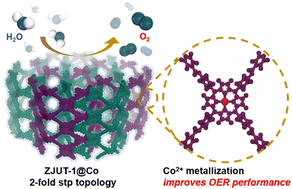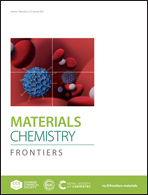Three-dimensional porphyrin-based covalent organic frameworks with stp topology for an efficient electrocatalytic oxygen evolution reaction†
Abstract
The rational design and construction of three-dimensional porphyrin-based covalent organic frameworks (3D COFs) with new topologies and functionalities is still challenging due to the scarcity of high-valency stereoscopic molecular nodes. Herein, we report a novel 2-fold interpenetrated 3D porphyrin-based COF (named ZJUT-1) with stp topology based on the 6-connected triptycene-based building block. Because of the abundantly available porphyrin coordination centers located in ZJUT-1, after post-metallization with cobalt ions, the as-obtained ZJUT-1@Co displays a low overpotential (295 mV) and a low Tafel slope (63 mV dec−1) in an electrocatalytic oxygen evolution reaction (OER), greatly outperforming its counterpart ZJUT-1. The enhanced charge density of metalloporphyrin centers is demonstrated to regulate the Bader charge of the intermediate *O and water affinity, thus lowering the overpotential of the potential limiting step (*O + H2O → *OOH + H+ + e−).



 Please wait while we load your content...
Please wait while we load your content...